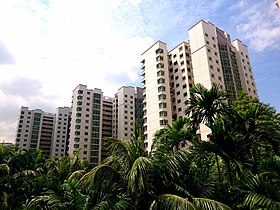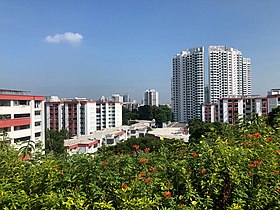The new towns of Singapore are planned communities located across Singapore that are designed to be self contained. Designed to house up to 300,000 residents, these new towns contain areas zoned for housing, recreation and employment, and are composed of multiple neighbourhoods, each of which is further subdivided into multiple precincts. Amenities in these new towns are provided through a multi-tiered system, and based on Housing and Development Board (HDB) guidelines. As of 2022, the country has 24 new towns.
The first new town in Singapore was constructed in the 1950s by the Singapore Improvement Trust (SIT), similar to British planning concepts and at low densities. Named after Queen Elizabeth II, Queenstown is Singapore's first new town with a town centre supporting seven neighbourhoods. Subsequently, after the HDB took over public housing development in the 1960s, the densities of new towns were increased and more amenities were included, and the HDB's first new town, Toa Payoh, contained industrial areas and a town centre with amenities. From the 1970s, new towns were built further from the city centre and were planned according to a new town model, containing neighbourhoods served by neighbourhood centres and a town centre for the entire town.
This new town model was revised in the late 1970s as the New Town Structural Model, introducing the concept of precincts and a "checkerboard model" in which public housing was interspersed with non-residential developments. From the 1980s, new towns incorporated larger flats, more distinctive layouts and housing block design, to cater to more affluent residents and to make the towns more unique respectively, and shopping malls were developed in town centres from the 1990s. The development of Punggol 21 saw the introduction of the Estate Model For New Town Planning, under which new towns comprised mixed-use developments connected together by a light rail system, and from the 2010s, new towns were planned with an increased focus on liveability and identity, through increased integration of technology and the use of the external environment to influence planning. In addition, design guides were introduced for each new town from 2018 in a bid to make new towns more distinctive.
The development of new towns within Singapore were in tandem with the construction of public housing in the country – managed by the Housing and Development Board (HDB) under a 99-year lease. The majority of the residential housing developments in Singapore are publicly governed and developed, and home to approximately 80% of the population. These flats which are located in these new towns are self contained with well-maintained schools, supermarkets, parks, shopping centres, healthcare services and sports and recreational facilities. Every new town consists of multiple Mass Rapid Transit stations (MRT) and bus stops that link residents to other parts of the country. Some new towns are also complemented by smaller Light Rail Transit stations (LRT).

